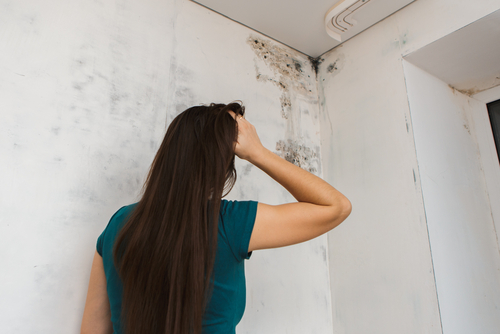Black mold is a type of fungus that looks dark green or black. Although there are many types of black mold, Stachybotrys chartarum (S. chartarum) is the most relevant and responsible for infections.
Black mold grows and spreads in materials that contain cellulose, e.g., fruits and vegetables, including paper products, wood products, and drywall. Unfortunately, black mold will likely make you sick if you have mold allergies.
Black mold triggers symptoms of allergies like runny nose or coughing. For most people, black mold doesn’t cause a significant illness or death. In addition, people who are immunocompromised may experience more severe symptoms.
Although you can’t eliminate mold allergies, treatment is available to manage your symptoms. If you suspect black mold is making you sick, consider speaking to a physician from a trusted urgent care center.
How Does Mold Exposure Occur?
You can experience exposure to black mold spores or any other black mold species by breathing in microscopic mold spores found in the air or by consuming those containing mold spores.
Any disruption of the mold colony, which may be as simple as slamming the door, knocking on contaminated furniture, or opening a window, can disperse the particles in the air.
Can Black Mold Make You Sick?
If you breathe black mold, the exposure will trigger an allergic reaction if you have a black mold allergy. Generally, an allergic reaction means your body has responded to the foreign material(black mold).
If you have a black mold allergy, the body’s first reaction after exposure to black mold is the creation of immunoglobulin E (IgE), a form of antibodies created by the body. After the first exposure, the mast cells become highly sensitive to black mold allergens.
The next time the mast cells encounter black mold spores, they release histamine and other chemicals. Histamine is what is responsible for immediate allergic symptoms. Then, symptoms develop very quickly, usually within minutes or seconds.
Lastly, chemicals trigger an ongoing inflammation.
Symptoms of Black Mold Exposure
Common symptoms of black mold exposure include:
- Coughing
- Wheezing
- Skin rash
- Sore throat
- Nasal congestion
- Red or itchy eyes
- Post nasal drip
Black mold can also trigger or worsen asthma symptoms, including:
- Shortness of breath
- Chest tightness and dry cough
- Wheezing
People with weakened immune systems are at a high risk of fungal infections, including lung infections caused by mold.
In addition, mold can cause different illnesses besides the well-known allergies, including:
- General irritation
- Infections
- Toxicity
- Systemic inflammation
People Who Are More Likely to be Affected By Mold
People who are more likely to get a severe form of lung infection when exposed to a mold include:
- People with a weak immune system(immunocompromised)
- Those receiving cancer treatment
- People taking medication that suppress their immune system
- People who’ve had organ or stem cell transplant
The following factors can also increase or decrease your reaction to mold:
- The duration of exposure
- Mode of exposure, whether inhalation or ingestion
- Nutrition status
- Hereditary factors
- Type of mold exposure
- Comorbid illnesses
- Immune system functionality and response
How to Prevent Black Mold Exposure
Although you can’t prevent all mold, you can reduce the amount of mold in your home and your exposure.
Here are a few ways to manage mold levels and prevent it from growing indoors:
- Keep your home clean, particularly in areas like the bathroom that may be prone to mold
- Repair any leaks in the roof or the walls that may increase moisture levels
- Use a dehumidifier to lower humidity levels— 30-50% humidity levels prevent the growth of black mold.
- Use exhaust fans in the bathroom and toilet
- Unblock rain gutters, which could block water flow and cause mold growth in the home
- Use an indoor air purifier with a (High-efficiency particulate air) HEPA filter. Alternatively, install a highly efficient furnace or ventilation system. Although a purifier cannot remove the source of mold, it prevents allergic symptoms.
- Clean and dry your home within 48 hours to prevent mold growth if it becomes flooded.
Diagnosis and Treatment of Black Mold
Diagnosis
There are no proven tests that can establish mold exposure. Even so, a healthcare provider can establish a mold allergy by reviewing your symptoms or by performing one of the following tests:
- Blood Test: The doctor can take a blood sample, send it to the lab, and evaluate specific antibodies that indicate the immune system’s sensitivity to different mold species.
- Skin Prick Test: The healthcare provider may apply a small amount of mold using a tiny needle to the skin. The skin will develop a rash, hives, or break out in bumps if you’re allergic to that mold.
Treatment
The best treatment for mold allergy is by avoiding exposure to triggers. However, mold is common, and you cannot altogether avoid it.
While there’s no cure for mold allergy, the following medications can ease your symptoms:
Antihistamines
Antihistamine helps ease symptoms such as runny nose, sneezing, and itching. These medications block histamine, a hormone the immune system releases after an allergic reaction.
The over-the-counter antihistamine medications include cetirizine (Zyrtec Allergy), loratadine (Alavert, or fexofenadine (Allegra Allergy. However, they can cause little to no drowsiness and dry mouth.
Alternatively, a doctor can prescribe a nasal spray such as olopatadine (Patanase) or azelastine (Astelin, Astepro). The common side effects of nasal sprays include nasal dryness and a bitter taste in your mouth.
Oral Decongestants
You can use over-the-counter decongestants such as Sudafed 12-Hour; however, they can raise blood pressure, making them risky for people with high blood pressure.
Nasal Corticosteroids
Nasal sprays prevent and treat inflammation caused by upper respiratory mold allergy. These are the most effective medications for most people, and healthcare providers offer them as the first alternative.
Montelukast
A healthcare provider can prescribe Montelukast(a single tablet) to block the action of leukotrienes— the immune system chemical that triggers allergic symptoms such as excess mucus.
Similar to antihistamine, montelukast is less effective than inhaled corticosteroids. However, patients can use it if they have mild asthma or can’t tolerate nasal sprays.
Allergy Shots: Your healthcare provider may recommend allergy shots with small amounts of allergens to prepare your immune system for future exposure.
Risk Factors of Black Mold Illness
Below are a few factors that will make you more likely to develop black mold allergy or worsen your mold allergy symptoms:
- A family history of black mold allergy: If most of your family members have a problem with asthma and allergies, you’re at a high risk of developing mold allergy.
- Poorly ventilated home: A house with tight windows and door seals will likely trap moisture indoors, hindering proper ventilation and creating ideal mold growth conditions. In addition, damp conditions in the bathroom, kitchens, bathrooms, and basements increase mold exposure.
- Working in an environment that exposes you to mold: People working in farming, dairy work, logging, carpentry, winemaking, and furniture repair are at high risk of mold exposure. In addition, working or living in a building exposed to excess water from leaky pipes or water seepage during floods can encourage mold growth.
- A house with high humidity: If you live in a home with high humidity above 50%, it increases the likelihood of mold growth in your home. Once the conditions are right, mold can grow anywhere, whether on a carpet, behind the framing, or in the basement. Unfortunately, exposure to high household mold increases can trigger mold allergy symptoms.
Possible Complications of Mold Exposure
Many allergic symptoms resemble hay fever reactions, which typically makes you uncomfortable but are not severe. However, specific allergic conditions triggered by mold exposure are severe.
Here are a few severe allergic conditions caused by mold exposure:
- Hypersensitivity Pneumonitis: Hypersensitivity pneumonitis is an immune system illness that triggers lung inflammation due to an allergic reaction to plants, chemicals, inhaled micro-organisms, or proteins. Unfortunately, it can take several months before your lungs heal from hypersensitivity pneumonitis. The condition can also cause permanent lung damage.
- Mold-Induced Asthma: If you’re allergic to mold, inhaling black mold spores can trigger an asthma flare-up. Symptoms of mold-induced asthma include wheezing, chest tightness, coughing, and shortness of breath.
- Allergic Fungal Sinusitis: Allergic fungal sinusitis is a common infection due to an allergic reaction to fungi in your nose. If untreated, the sinus becomes filled with thick mucus, and nasal polyps may also form.
When should I go to Urgent Care for mold exposure?
See a doctor if the following bothersome symptoms persist:
- Sneezing
- Watery eyes
- Shortness of breath
- Wheezing
- Stuffy nose
Seek Relief from Black Mold Allergies at Newport Urgent Care
If you’re allergic to black mold, exposure to black mold spores will trigger a nasty allergic reaction. For immunocompromised people, it may cause a severe lung infection or trigger mold-induced asthma.
Fortunately, you can prevent a potential complication by seeking quality and timely care from a health facility.
Newport Urgent Care Center is a well-equipped health facility with qualified and experienced physicians dedicated to the well-being of patients.
Don’t let black mold exposure compromise your health. Contact Newport Urgent Care at 949.752.6300 or visit us online to schedule your consultation in Newport Beach, CA.



